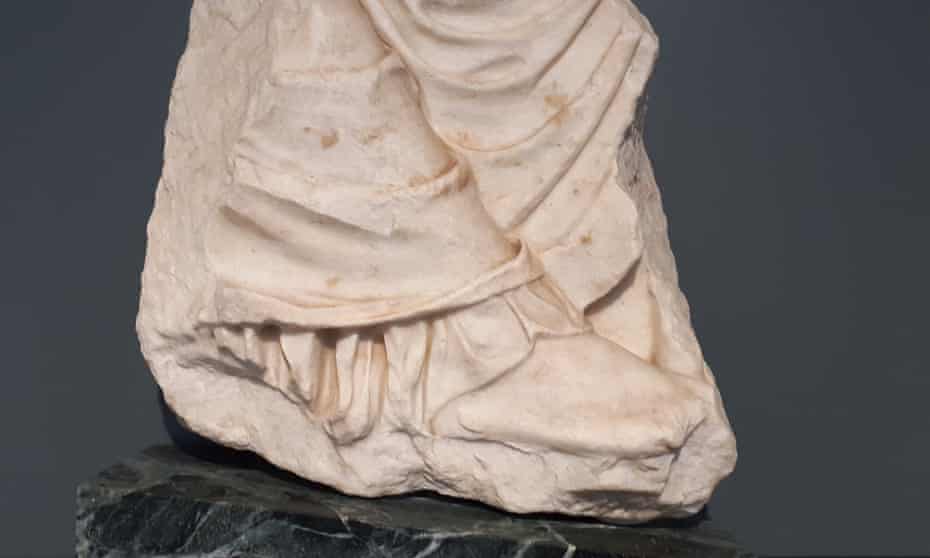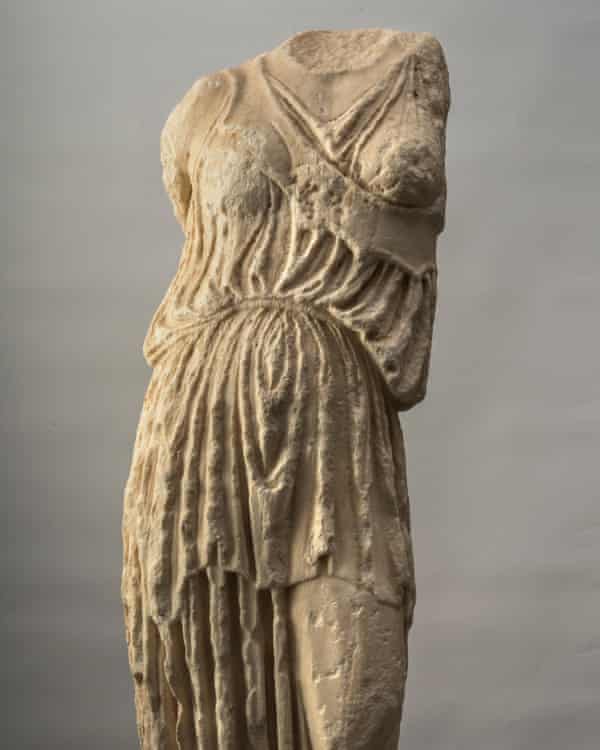Italy returns Parthenon fragment to Greece amid UK row over marbles
Loan deal could renew pressure on Britain to repatriate ancient Parthenon marbles to Athens

The fragment, part of a draped figure from the east side of the Parthenon frieze. Photograph: AP
Italy is returning a fragment belonging to the Parthenon’s eastern frieze to Greece in a breakthrough deal that could renew pressure on Britain to repatriate the 2,500-year-old Parthenon marbles removed by Lord Elgin in the early 19th century.
The marble fragment, which depicts the foot of a goddess, either Peitho or Artemis, peeking out from beneath an elaborate tunic, is currently held at the Antonino Salinas Regional Archaeological Museum in Palermo, Sicily. It was originally bought by the University of Palermo from the widow of Robert Fagan, the British consul for Sicily and Malta, after his death in 1816.
The artefact is being returned on a four-year loan as part of a cultural exchange agreement between Sicily and Greece, with the intention for the loan period to be extended by a further four years. However, the move back to Greece could eventually become permanent.
Italy is returning a fragment belonging to the Parthenon’s eastern frieze to Greece in a breakthrough deal that could renew pressure on Britain to repatriate the 2,500-year-old Parthenon marbles removed by Lord Elgin in the early 19th century.
The marble fragment, which depicts the foot of a goddess, either Peitho or Artemis, peeking out from beneath an elaborate tunic, is currently held at the Antonino Salinas Regional Archaeological Museum in Palermo, Sicily. It was originally bought by the University of Palermo from the widow of Robert Fagan, the British consul for Sicily and Malta, after his death in 1816.
The artefact is being returned on a four-year loan as part of a cultural exchange agreement between Sicily and Greece, with the intention for the loan period to be extended by a further four years. However, the move back to Greece could eventually become permanent.
 A headless statue of Athena, to be loaned to the Antonino Solinas museum in Palermo. Photograph: Antonino Solinas museum
A headless statue of Athena, to be loaned to the Antonino Solinas museum in Palermo. Photograph: Antonino Solinas museumIn return, the Acropolis Museum in Athens will loan the Palermo museum a 5th-century BC headless statue of the goddess Athena, as well as an 8th-century BC amphora.
The deal, which includes an exchange of cultural initiatives between the two museums, comes after several years of negotiations between Sicilian and Greek authorities.
“Sending back to the context of its origins a small, but significant, fragment belonging to the Parthenon has a very strong symbolic value,” said Sicily’s councillor for culture, Alberto Samonà. “It is also a response to the international debate [about the Parthenon artefacts]. But I don’t want to get into that debate. For us, this is a gesture of friendship – Greece and Sicily are two areas of the Mediterranean that share a common story.”
The fragment was loaned to Greece in 2002 and in 2008. Samonà said the latest transfer could become permanent, but that it would be up to the Italian culture ministry to take the measures needed to make that happen.
It is not known how Fagan, an amateur archaeologist, acquired the fragment, although one theory suggests it might have been given to him by Elgin, the British aristocrat who excavated the bulk of the ancient Parthenon marbles between 1801 and 1804 before selling them to the British Museum in 1816, where the artefacts are currently on display.
Greece has long fought for the marbles to be repatriated from the UK. In November, the Greek prime minister, Kyriakos Mitsotakis, demanded that Britain return the marbles to Greece, while at the same time offering to loan some Greek historical treasures to the British Museum. In response, Downing Street said returning the marbles was a matter for the British Museum. The UK prime minister, Boris Johnson, had previously said the marbles would remain in Britain, arguing that they were legally acquired.
*********
kt comments:
Britain has looted treasures from around the World to which she refuses to return same, being the shameless arrogant thief that she was/is, apart from the reality that if the British were to return all looted treasures to their countries of origin, the British Museum would practically be denuded of contents, wakakaka.

part of the looted Elgin Marbles - it is as British as char-koay-teow would be
Koh-i-Noor Diamond from India.

Rosetta Stone
Regarding the Koh-i-Noor Diamond, when its original owner the Maharajah of Punjab, Ranjit Singh, died in 1839 he bestowed the gem to a sect of Hindu priests.
... the British learned of Ranjit Singh’s death in 1839, and his plan to give the diamond and other jewels to a sect of Hindu priests, the British press exploded in outrage. “The richest, the most costly gem in the known world, has been committed to the trust of a profane, idolatrous and mercenary priesthood,” wrote one anonymous editorial. Its author urged the British East India Company to do whatever they could to keep track of the Koh-i-Noor, so that it might ultimately be theirs.
But the colonists were first forced to wait out a chaotic period of changing rulers. After Ranjit Singh’s death in 1839, the Punjabi throne passed between four different rulers over four years. At the end of the violent period, the only people left in line for the throne were a young boy, Duleep Singh, and his mother, Rani Jindan. And in 1849, after imprisoning Jindan, the British forced Duleep to sign a legal document amending the Treaty of Lahore, that required Duleep to give away the Koh-i-Noor and all claim to sovereignty. The boy was only 10 years old.
From there, the diamond became a special possession of Queen Victoria. It was displayed at the 1851 Great Exposition in London, only for the British public to be dismayed at how simple it was. “Many people find a difficulty in bringing themselves to believe, from its external appearance, that it is anything but a piece of common glass,” wrote The Times in June 1851.
Learning of the Ranjit Singh's legacy to the Hindu priests, the Poms went wild. This is what the Smithsonian Magazine said:
But the colonists were first forced to wait out a chaotic period of changing rulers. After Ranjit Singh’s death in 1839, the Punjabi throne passed between four different rulers over four years. At the end of the violent period, the only people left in line for the throne were a young boy, Duleep Singh, and his mother, Rani Jindan. And in 1849, after imprisoning Jindan, the British forced Duleep to sign a legal document amending the Treaty of Lahore, that required Duleep to give away the Koh-i-Noor and all claim to sovereignty. The boy was only 10 years old.
From there, the diamond became a special possession of Queen Victoria. It was displayed at the 1851 Great Exposition in London, only for the British public to be dismayed at how simple it was. “Many people find a difficulty in bringing themselves to believe, from its external appearance, that it is anything but a piece of common glass,” wrote The Times in June 1851.
 \
\Koh-i-Noor Diamond, cut to fit onto the British crown
But let's be fair, the Poms still have their Stongehenge, though that pile of rocks might not fit into the British Museum.

"Some" other treasures the Poms looted were:
The Amaravati Marbles from Andhra Pradesh, India

One of 120 pieces
The Wine Cup of Shah Jahan, India

The Benin Bronzes, Nigeria

One of of more than a thousand metal plaques and sculptures
The Ethiopian Manuscripts

One of 130 pieces in Britain
Etc Etc Etc ... eff-ing robber
https://www.theguardian.com/world/2000/apr/21/russia.iantraynor
ReplyDeleteYour Fav Russia also looted a lot of art, and also refused to return it.
Unlike your Pommie Great White Mother, Russia to return looted art, but not to Germany
Delete